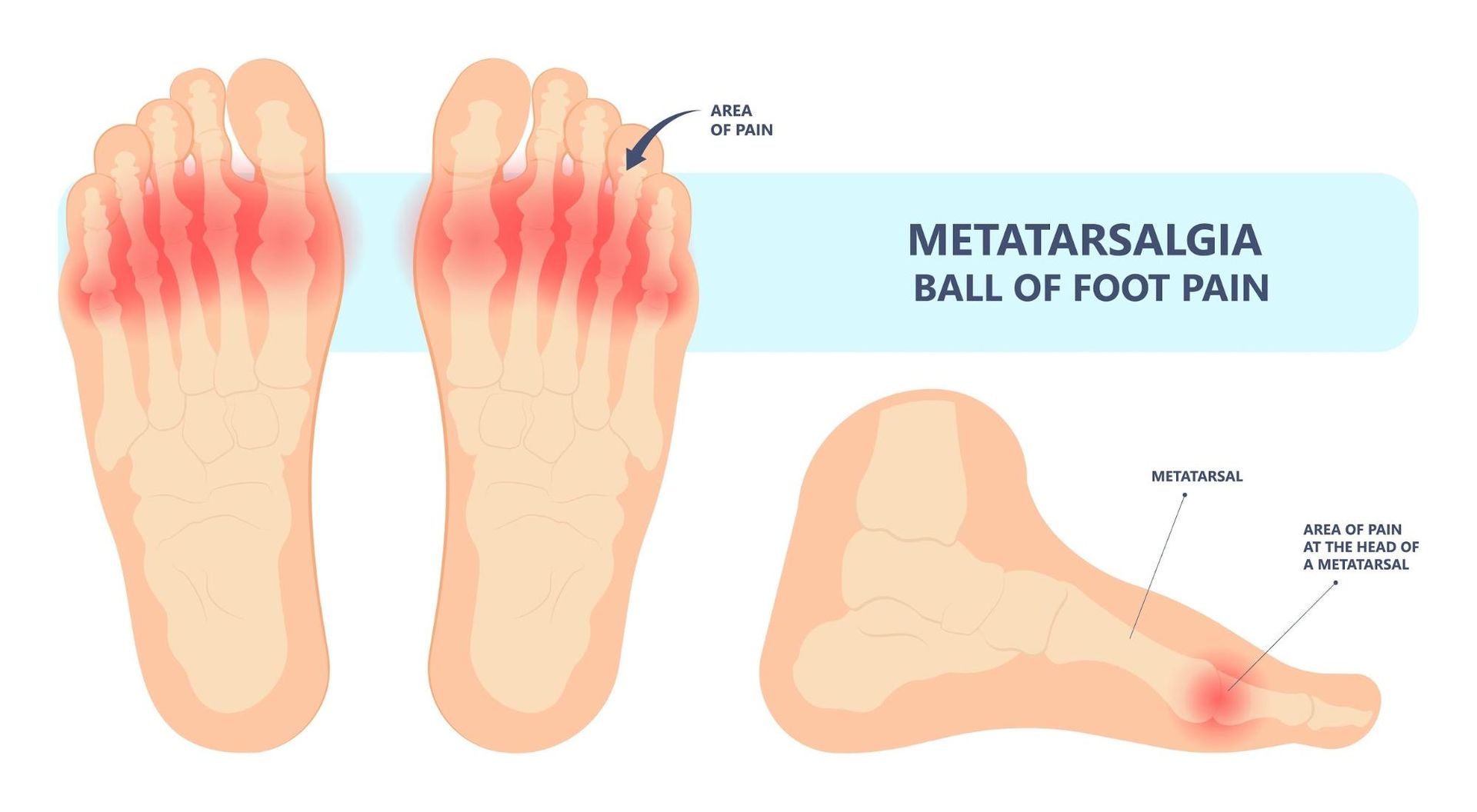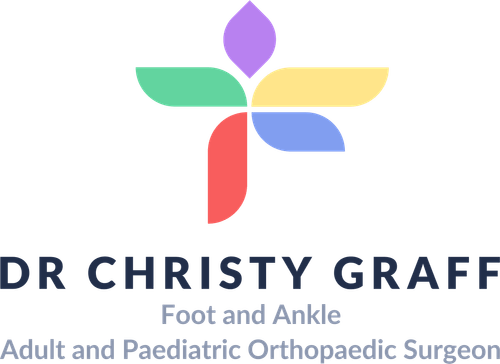Metatarsalgia
What is Metatarsalgia?
Metatarsalgia describes pain and inflammation on the ball of the foot on the sole.


Impact of Metatarsalgia on Anatomy and Health
Metatarsalgia affects the metatarsal region of your foot, which plays a key role in weight distribution during movement. When this area is inflamed or under excessive pressure, it can lead to:
- Pain and Discomfort: Sharp, aching, or burning pain in the ball of the foot.
- Altered Gait: You may unconsciously change how you walk to avoid pain, which can strain other body parts, such as your knees, hips, or back.
- Decreased Mobility: Persistent pain may reduce your ability to engage in physical activities, impacting overall health and fitness.
Causes and Risk Factors for Metatarsalgia
Metatarsalgia is caused by too much pressure or loading on one area of the foot.
Risk factors include:
- A short first metatarsal (bone in the foot near the big toe) compared with the second metatarsal (similar bone near the 2nd toe), so the toe takes too much load.
- An imbalance of the tendons to the toes so it forces that area of the bone closer to the ground
- Repetitive heavy weight bearing such as long-distance running or high-impact sport
- A tight Achilles tendon
- Ill-fitting shoes or high heel shoes
- Increased weight
- Stress fractures
- Other lesser toe deformities (lesser toes are toes 2-5)
- Bunions
- Torn ligaments in the feet
- Abnormal foot shape
- Increased age: the fat pad on the ball of the foot gets thinner over time
- Rheumatoid arthritis
- Other conditions, such as Morton’s Neuroma (see Morton’s Neuroma Information Sheet)
Symptoms of Metatarsalgia
- Pain over the ball of the foot, worse with increased weight-bearing.
- Increased pain during physical activity or while walking barefoot.
- A feeling of having a pebble or lump in your shoe.
- Numbness or tingling in the toes.
- Swelling or inflammation in the affected area.
Prevention of Metatarsalgia
Prevention strategies focus on reducing pressure and providing adequate support for the feet:
- Choose Proper Footwear:
- Wear shoes with good arch support and cushioning.
- Avoid high heels or narrow shoes that compress the toes.
- Maintain a Healthy Weight: Reducing body weight minimises stress on the feet.
- Use Orthotics: Custom insoles can distribute pressure more evenly.
- Strengthen Foot Muscles: Engage in exercises to improve foot strength and flexibility.
- Pace Physical Activities: Gradually increase intensity and duration to avoid overuse.
- Rest and Recover: Allow time for your feet to recover after high-impact activities.
Types of Metatarsalgia
Metatarsalgia can be categorised based on its causes or the specific area of the foot affected:
- Primary Metatarsalgia: Caused by structural abnormalities in the foot, such as high arches, hammertoes, or a long second metatarsal bone.
- Secondary Metatarsalgia: Results from external factors like overuse, trauma, or medical conditions (e.g., arthritis or diabetes).
- Iatrogenic Metatarsalgia: Occurs as a complication of surgery, such as after bunion removal or other foot procedures that alter biomechanics.
- Neuropathic Metatarsalgia: Related to nerve issues, such as Morton’s neuroma, where nerve compression causes pain in the metatarsal area.
Stages of Metatarsalgia
Metatarsalgia progresses in stages based on the severity and duration of symptoms:
- Early Stage:
- Pain is mild and occurs only during high-impact activities.
- Rest alleviates discomfort.
- Moderate Stage:
- Pain becomes more frequent, even during normal walking or standing.
- Swelling or inflammation in the ball of the foot may be noticeable.
- Advanced Stage:
- Chronic pain persists even at rest.
- Secondary issues such as altered gait, calluses, or foot deformities may develop.
- Risk of complications like stress fractures increases.
Diagnosis of Metatarsalgia
A clinical examination will help find the cause of the pain. While standing, an X-ray of both feet will also help diagnose bony problems. A CT or MRI scan may be required if the cause is unclear.
Management of Metatarsalgia
Treatment aims to relieve pain by offloading the ball of the foot. This can include:
- Shoes: Extra padding in shoes, such as sneakers, helps cushion the painful area during walking. It also helps if they have a rocker bottom on the sole. Avoiding high heels will also help relieve pain. Also, avoiding walking barefoot on hard ground can help decrease the pain and inflammation
- Orthotics: An orthotic in the shoe can help with a 'cut out' for the painful area of the feet
- Medications: Paracetamol and or ibuprofen (anti-inflammatory medications) can help with the pain during acute periods of pain
- Physiotherapy: Stretching the Achilles can sometimes help relieve pressure on the ball of the foot
- Weight loss: the more weight put through the foot, the worse the pain and progression can be.
- Surgery: Depending on the cause of the pain, surgery can help relieve the pain. This can range from soft tissue release to bony foot reconstruction.
What if Metatarsalgia is Untreated?
If left untreated, metatarsalgia can lead to:
- Chronic Pain: Persistent discomfort that interferes with daily activities.
- Foot Deformities: Conditions like hammertoes, bunions, or calluses may worsen.
- Altered Gait: Compensatory walking patterns can strain other joints, leading to knee, hip, or back pain.
- Stress Fractures: Increased pressure on the metatarsal bones may cause fractures over time.
- Reduced Mobility: Severe pain may limit physical activity, impacting overall health and quality of life.
Early intervention is key to managing metatarsalgia effectively and preventing complications.
If you want an opinion on this condition, please book an appointment with Dr Christy Graff.
